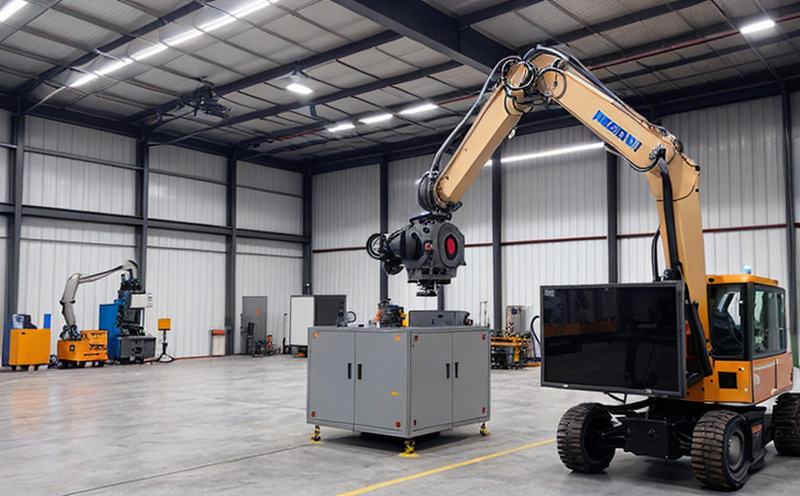UL 4600 Safety of Autonomous Industrial Robotics Systems
The UL 4600 standard is a critical framework designed to ensure the safety and reliability of autonomous industrial robotics systems. This standard, developed by Underwriters Laboratories (UL), focuses on the design, manufacturing, testing, and certification processes that guarantee these robotic systems operate safely in complex industrial environments.
Autonomous industrial robots are increasingly becoming integral components in modern manufacturing facilities due to their ability to perform tasks with precision and efficiency. However, this integration introduces new challenges related to safety and risk management. The UL 4600 standard addresses these concerns by providing a comprehensive set of guidelines that cover the entire lifecycle of autonomous industrial robotics systems.
The standard covers various aspects such as electrical safety, mechanical integrity, human-machine interaction, environmental considerations, and cybersecurity measures. It ensures that these robots are equipped with robust protection mechanisms to prevent accidents or malfunctions that could harm workers, damage equipment, or disrupt production processes. Compliance with UL 4600 is essential for manufacturers looking to meet regulatory requirements in countries like the United States and Canada.
The testing protocols outlined in this standard go beyond basic performance checks; they emphasize safety under real-world conditions where unforeseen scenarios may arise. This approach helps ensure that autonomous industrial robots function reliably even when faced with unexpected situations or harsh operating environments.
By adhering to the UL 4600 standard, companies not only demonstrate their commitment to safety but also enhance their reputation by showing leadership in responsible technology deployment. Moreover, compliance opens up opportunities for international markets where adherence to specific standards is required.
In summary, UL 4600 provides a robust framework that ensures the safe and reliable operation of autonomous industrial robotics systems. Its comprehensive approach covers multiple critical areas such as electrical safety, mechanical integrity, human-machine interaction, environmental considerations, and cybersecurity measures. Compliance with this standard helps manufacturers meet regulatory requirements while enhancing their reputation and opening doors to international markets.
Why It Matters
The implementation of UL 4600 is crucial for several reasons. Firstly, it underscores the importance of safety in industrial robotics systems by mandating rigorous testing procedures that go beyond standard benchmarks. Secondly, compliance with this standard ensures robust protection mechanisms are incorporated into autonomous industrial robots, reducing risks associated with unexpected malfunctions or accidents.
From a business perspective, adhering to UL 4600 can significantly reduce liability concerns for manufacturers and end-users alike. By demonstrating adherence to recognized safety standards, companies signal their commitment to quality and responsible technology deployment. This not only enhances reputation but also fosters trust among stakeholders such as regulatory bodies, insurance providers, and potential customers.
Moreover, compliance with UL 4600 helps ensure that autonomous industrial robots are capable of operating safely in diverse environments without compromising on performance or reliability. This capability is particularly important given the increasing complexity of modern manufacturing processes where multiple robotic systems often need to work together seamlessly.
In essence, the significance of complying with UL 4600 lies in its role as a benchmark for ensuring the safe and reliable operation of autonomous industrial robotics systems. It addresses critical safety concerns by mandating comprehensive testing procedures that cover various aspects including electrical safety, mechanical integrity, human-machine interaction, environmental considerations, and cybersecurity measures.
Why Choose This Test
Selecting the UL 4600 Safety of Autonomous Industrial Robotics Systems test is a strategic decision for several reasons. Firstly, it offers a robust framework that ensures comprehensive safety checks are performed on autonomous industrial robotics systems. Secondly, this standard provides clear guidelines on how to design and implement protection mechanisms within these robots, which enhances overall reliability.
Compliance with UL 4600 can significantly reduce liability risks for manufacturers by demonstrating adherence to recognized safety standards. This not only boosts reputation but also fosters trust among stakeholders such as regulatory bodies, insurance providers, and potential customers. Additionally, meeting this standard helps ensure that autonomous industrial robots are capable of operating safely in complex environments without compromising on performance or reliability.
Furthermore, choosing UL 4600 for testing ensures consistency across different regions where compliance with specific standards is required. This international recognition can open up new markets and opportunities for manufacturers who wish to expand their reach globally.
In summary, selecting the UL 4600 Safety of Autonomous Industrial Robotics Systems test offers numerous benefits including comprehensive safety checks, clear guidelines on designing robust protection mechanisms, reduced liability risks, enhanced reputation, increased stakeholder trust, consistent compliance across regions, and expanded market opportunities. These factors make it an ideal choice for manufacturers looking to ensure their autonomous industrial robotics systems meet the highest standards of safety and reliability.
Use Cases and Application Examples
The UL 4600 Safety of Autonomous Industrial Robotics Systems test finds extensive application in various sectors including automotive manufacturing, electronics assembly, food processing, pharmaceuticals production, logistics distribution centers, and more. In the automotive industry, autonomous robots play a key role in assembling vehicles by performing tasks like welding, painting, and quality inspection.
In electronics assembly plants, these robots are used for soldering components onto circuit boards with precision that surpasses human capabilities. Similarly, food processing facilities utilize autonomous robots to handle delicate products such as fruits or vegetables during packaging processes. Pharmaceutical manufacturers rely on them for handling hazardous materials safely throughout production lines.
At logistics distribution centers, autonomous robots streamline order fulfillment by efficiently moving pallets between storage areas and loading docks. These examples illustrate how UL 4600 ensures safe operation across diverse industries where robotic systems contribute significantly towards improving productivity and efficiency.





